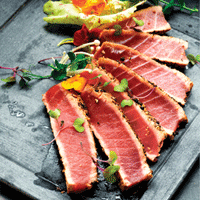Forget about rotisserie chicken, who’s up for braised rabbit to go?
It wasn’t long ago the term home meal replacement conjured images of grease-laden translucent cardboard containers, soggy fries and spit-skewered chicken. A step up from frozen TV dinners, maybe, although hardly haute cuisine. But there’s good news for hungry consumers on the run — new players have emerged on the scene, taking the humble HMR to new heights. (Braised rabbit with mustard and balsamic, anyone?) For modern foodies who, ironically, know more about the food they eat than ever before, but have little inclination towards actually cooking, the idea of restaurant-quality meals prepared by bona fide chefs and reheated at home is gaining serious traction.
What’s encouraging to operators in the HMR sector is that the research numbers for this segment, at least from a restaurateur’s perspective, look bright despite a difficult economic climate. “We’re seeing a bit of a switch in the HMR market, in overall opportunity, from grocery stores or QSRs where traffic is declining, towards casual or full-service restaurants,” says Robert Carter of the NPD group in Toronto. “This suggests consumers are looking for higher quality, stronger flavour profiles and larger menu selections,” he adds.
Canadians on the West Coast looking for more HMR choices need look no further than Anne Milne, former executive chef with Shangri-La hotels in Beijing and Xian, China. Milne, who runs Kitchen Arts Management in Vancouver, works closely with grocery chains to design home meal replacement options that create buzz and boost sales. “HMR is an alternative to fast food and even full-service restaurant meals,” she says. “At the end of a busy day, many people want a quick way to feed themselves and their families, but they want to eat at home. Key considerations for customers are value, freshness, variety, taste profile and, for more and more consumers, whether it’s healthy.”
Milne notes that today’s best HMRs are far from ordinary, bland affairs, with popular options including, “ethnic flavours such as Asian, Indian and foods that are hot and spicy; thin-crust pizzas; gourmet grilled panini and wraps with premium ingredients. There’s also an increasing demand for vegetarian options,” she says.
While the value proposition of any item is key, NPD’s Carter believes that shouldn’t be confused with a simple price imperative. According to his research, consumers are willing to spend more money on a smaller number of items if those items are of high quality. “I don’t think it’s really driven by price,” he says. “In the HMR market, we’ve seen the average check grow by six per cent, even as the average number of items per customer is in decline.” That means there’s an opening for savvy, higher-end establishments to enter the fray. “There’s an opportunity for more upscale outlets, with more advanced menus to take advantage of this shift,” says Carter. “Grabbing burgers and fries or grocery store rotisserie chicken on the way home is in decline. Consumers are trading out of that category.”
The call for higher-quality food is music to the ears of industry heavyweight Mark McEwan, who recently threw his hat into the grocery and home meal replacement ring. Owner/chef of some of Toronto’s top restaurants (North 44, Bymark and One), McEwan opened his eponymous grocery store about six months ago and has since seen his pre-made business boom, to the point where he says it represents the largest volume in terms of sales. “Half of what we have on offer at the meat counter is pre-marinated or in sous-vide bags ready to go,” he says. “People just fly at it. Reheating is the new cooking.”
Given what customers are reheating from McEwan’s shiny new display cases — braised rabbit ($12.95), truffle mac and cheese ($13.95) veal shank mushroom pie ($12.95) and North 44 banana-leaf-wrapped halibut (18.95/lb) — the fare is hardly what most people associate with takeout. But McEwan says the wide variety he offers, along with the quality and the convenience factor, is a winning combination. “We’ve only been open for about six months but it’s been great. We’re constantly learning and trying new things, figuring out what works and what doesn’t,” he says. “It never ceases to amaze me that some people don’t even want to cut up a melon anymore. If we do the processing on just about anything, it literally walks out the door.”
The importance of convenience and quality is something other HMR operators are noticing. “We see more and more people looking for something to grab on the way home, but we refer to it as take-away, not takeout. And it’s certainly not ‘to-go,’” says Jane Wright, owner of Jane’s on the Common, a bustling restaurant in Halifax. About a year ago, Wright opened Jane’s Next Door, the home meal replacement (or ‘take-away’) wing of her popular restaurant. From that next-door location, Wright sells frozen versions of some of the restaurant’s bestsellers as well as unique dishes suited to the outlet.
The idea of developing menu staples strictly for the take-home or reheat-at-home crowd can be seen at other full-service outlets across the country, such as Rangoli in Vancouver, where fans of Vikram Vij’s restaurant can head next door and bring home Punjabi lamb curry ($10.50) or natural chicken in Vij’s masala ($12.75) from its market counter. For Torontonians, options include Jamie Kennedy’s Gilead Café, where slow-food devotees can grab patés, terrines as well as a daily selection of oven-ready items, and Amaya, a chic Indian food standby in midtown that also boasts an express option up the street. There, ready-to-eat Indian fare such as Saag lamb ($13.95) or spicy chicken vindaloo ($12.95) is available to customers who would rather dine at home (or who can’t get a table at the busy restaurant).
“I refer to it as convenient slow food,” says Wright of her dishes that have to be baked in an oven after purchase. But the key for operators like Wright and McEwan is maintaining the quality of the meals. “The ingredients are all good, honest and local,” she says. “People today are much more interested in where their food is coming from. We also make everything in small batches, because you can’t make really great food in large quantities.”
In fact, McEwan says his loyal following of customers looking for a restaurant experience at home wouldn’t let him get away with anything less, nor would he be comfortable trying. “There’s a certain trust there, and it’s all part of how I put my shingle out. If it doesn’t work we’ll change it, because in the end it has to work.”
Making it work means that HMR options have to not only taste great, he says, but they must be visually appealing as well, something McEwan compares to buying a cookbook. “It’s just not entertaining without the visual stimulation.”
When his team prepared tuna tartar for the first time, the uncompromising chef wasn’t surprised it didn’t sell terribly well. “It just didn’t look like it wanted to be sold,” he says. “In the end, what’s really important is that a dish tastes great and it’s fresh. But we’re also finding people love the story behind what we’re doing. It creates an impression.”
HMRs have come a long way in the past several years, and given the accelerating pace of life among the next generation of food-conscious consumers (a group of young professionals that’s increasingly inept in the kitchen), it’s hard to see this market segment dying. In fact, his early success in the field has McEwan pondering a second grocery location in Toronto’s swanky Yorkville neigbourhood. As Milne says, “In a family, if both parents work and the kids are busy in after-school activities, they want someone else to do the cooking for them when they get home. It’s the same for single people — you work hard all day; sometimes you just want to go home and cocoon.”





















